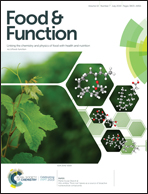Insight into the effects of deglycosylation and glycation of shrimp tropomyosin on in vivo allergenicity and mast cell function
Abstract
Shrimp tropomyosin (TM) is a glycoprotein allergen with high lysine content, however, there is little data on how deglycosylation and glycation modify the allergenicity of TM. In this work, the effects of deglycosylation (enzymatic and chemical) and glycation of TM by glucose on in vivo allergenicity and mast cell function were investigated using BALB/c mouse and RBL-2H3 mast cells. Compared with TM, after deglycosylation, the deglycosylated TMs (DGTMs) exacerbated the in vivo allergenicity and mast cell allergy response. As for the TM glycated by glucose (TM-G), glycation led to weaker allergy responses on mouse and mast cells, which might be due to glucose destroying the epitopes with glycation sites. Moreover, the glucose residues on TM-G functioned as both a resistance to prevent the accessibility of TM-G to the IgE on mast cell and masking epitopes. Therefore, deglycosylation of TM was not suitable for desensitizing TM-induced food allergy, while glycation of TM might be applied to desensitize TM allergenicity, which could provide new insight into food allergy desensitization for larger cohorts of shrimp-allergic patients.



 Please wait while we load your content...
Please wait while we load your content...